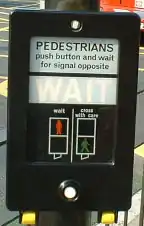Pelican crossing
A pelican crossing (previously pelicon crossing, which stood for "pedestrian light controlled crossing") is the UK and Irish name for a type of pedestrian crossing, which features a pair of poles each with a standard set of traffic lights facing oncoming traffic, a push button and two illuminated, coloured pictograms facing the pedestrian from across the road. These are a red, stationary person to indicate that it is not safe to cross, and a green, walking person to indicate that it is safe to do so. Pelican crossings also provide non-visual indication that it is safe to cross, such as a beep, vibrating button or tactile rotating cone in order to assist visually impaired pedestrians.
.jpg.webp)
Apart from the United Kingdom, this term for a zebra crossing with traffic lights is also used in Australia.
Overview
Pelican crossings are ubiquitous in many countries, but usage of the phrase "pelican crossing" is confined mainly to the UK, where they were invented, and to Ireland. A comparable system called the HAWK beacon is used in the United States.


The name is derived from PELICON, a portmanteau of pedestrian light controlled. The term pelican crossing originated in the United Kingdom, Crown Dependencies and British Overseas Territories, but similar traffic control devices are in use throughout the world. The term is also used in the Republic of Ireland.
The pelican crossing was a relatively minor development of the "x–way" crossing. This earlier crossing was largely identical to the pelican crossing, but instead of a green light for motorists, featured a white diagonal cross. The intention of this was to distinguish the crossing lights from any nearby junction (standard) traffic lights. The white cross was widely criticised and users and motoring organisations alike called for the white cross to be replaced by a green light. With some changes to the light timings and road markings, the "x–way" crossing became the pelican crossing.
In the United Kingdom, the pelican crossing was the first definitive light-controlled crossing for pedestrians, introduced in 1969. This was after the earlier failed experiment of the panda crossing. Previously only zebra crossings had been used, which have warning signals (Belisha beacons), but no control signals. The pedestrian lights are situated on the far side of the road to the pedestrian. A puffin crossing has the lights on the same side as the pedestrian; a toucan crossing is a crossing for pedestrians and bicycles; a pegasus crossing allows horse riders to cross as well.
Additionally, a pelican crossing, as distinct from a puffin crossing, has the special feature that while the green man flashes to indicate that pedestrians may continue crossing but may not start to cross, the red light changes to an amber flashing light permitting cars to pass if there are no further pedestrians. This reduces the delay to traffic.
Under UK law,[1] pelican crossings that go straight across the road are defined as a single crossing, even when there is a central island. Therefore, traffic in both directions must wait until pedestrians have finished crossing and the signal is green or flashing amber. This rule is different from similar standard pedestrian crossings where each portion of the crossing is treated as a separate crossing. However, at installations where the crossings that cross each carriageway are separate crossings, the crossing is staggered.
In 1974, cast from Dad's Army performed a public information film to explain the pelican crossing, and how it works.[2][3] In 1976, Paul Greenwood sung "The Pelican Crossing Song", again explaining how a pelican crossing works. In 2000, Shooglenifty incorporated samples of a pelican crossing into their album Solar Shears.
Statutory authority for pelican crossings was removed in the 2016 update of the Traffic Signs Regulations and General Directions. After 22 October 2016, no new pelican crossings can be installed on public highways in the UK, except work in progress where there was a six-month saving. Puffin crossings are to be installed instead. [4]
Internationally

- In Hong Kong, where control panels are also used as in the United Kingdom, no zig-zag lines are marked. At some crossings the traffic signals still turn to red; but at much longer intervals.
- In Jakarta, Indonesia, pelican crossing utilising the same mark as zebra crossing.
- A HAWK beacon, used with a standard pedestrian crossing signal, stops traffic when a pedestrian pushes a button to cross, but goes dark unless activated. It was allowed in experimental applications in the United States until 2009 and is now a standard option for transportation engineers.
- British Columbia, Canada, indicates pedestrian-controlled crossings using flashing green signals.[5] When a pedestrian activates the signal, the flashing green turns steady green, followed by yellow and red. When the crossing phase is complete, the signal returns to flashing green.
- In Norway, similar crossings (though without control panels) are common in urban and suburban areas. In such crossings the pedestrians usually are met by a red man. They push a button, which gives a "pipp". After some seconds, they pedestrians get a green man, usually also a beeping signal. In addition, pedestrian crossings are marked with zebra stripes and do sometimes have a speed hump. It is permitted to cross against red light or red man if it may be done without any danger.
References
- "Using the road - Pedestrian crossings (191 to 199)". The Highway Code. Retrieved 9 May 2019.
- "Pelican Crossing (Dad's Army) (1974)". 8 October 2009. Retrieved 10 June 2015.
- "Pelican Crossing-Motorist-Dads Army". 19 November 2009. Retrieved 10 June 2015.
- "DFT Circular 01/2016 - The Traffic Signs Regulations and General Directions 2016" (PDF). Department for Transport. HMSO. 2015. p. 63 section 17.6. Retrieved 26 May 2018.
- ICBC Archived 22 October 2013 at the Wayback Machine, Chapter 3, page 9
- The History of British Roadsigns, Dept. for Transport, 2nd Edition, 1999.
External links
- BBC article, on the introduction of Panda crossings, and subsequent developments.